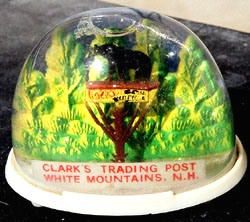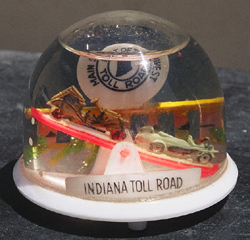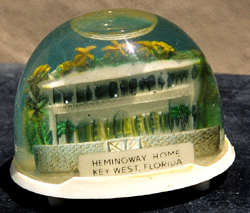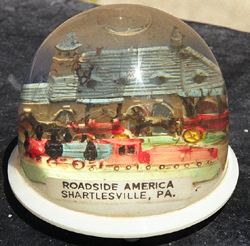AMERICA’S
HIGHWAY ATTRACTIONS AND SOUVENIRS

Clark's
Trading Post
White Mountains, N.H.
Roadside
travel is not what it used to be. Not by a long shot. Travel across
America, in the early days was fun and a new adventure was found around
every turn in the road. Between 1915 and the late 20’s, and again
after World War II, family highway travel was helped along by promotions
from the Oil companies like Texaco, Mobil, Sunoco, Gulf and Phillips
66. Special devices were used like trained bears doing tricks, free
marriages, interest free credit cards or at the very least, free road
maps were used to lure travelers onto the roadways.
From these beginnings "auto gypsies" or "auto-bummers"
(Highway Hangouts, 1997), as they first were called, stayed in tents
at tourist Parks. Once these state and city supported parks caught on,
numerous motels and Mom and Pop attractions began to spring up. As motels
emerged from Tourist Parks many had to get the traveler’s attention.
Indian Head Motel in Lincoln, New Hampshire added a 72 foot lookout
tower. "For ten cents you could get quite a view" (Highway
Hangouts, 1997). Early roadside architecture of signs, motels and gas
stations began to take the form of imaginative shapes and symbols. The
Wig-Wam Motel in Southwestern California’s Cave City had tee-pee
shaped cabins. A huge cowboy hat, a giant boot, a life size dinosaur,
an oversized Uncle Sam, a towering Paul Bunyon and the Ox, Babe, or
a full size B-2 Bomber were some other examples of these fun architectural
treatments.
As the number of cars hitting the highways increased, so did the highways
themselves. Turnpikes, Toll-ways and Thruways were born. Oklahoma, Indiana,
Kentucky, Pennsylvania, Illinois, New Jersey and New York all established
these first pay as you go turnpikes.

Indiana Tollroad
Main Street of the Midwest
While there were thousands of restaurants and refreshment stands, they
needed to stand out from the rest to attract the numbers of tourists
now coming by. So, entertainment, animals and characters were added
to distinguish themselves from the rest. Many early amusement type parks
also sprung up. Some of these early roadway attractions are still in
operation today. Clarks’ Trading Post in Lincoln, New Hampshire,
http://www.clarkstradingpost.com/,
South of the Border in Dillon, South Carolina(see below), http://www.pedroland.com/,
and Wall Drug in Wall, South Dakota
http://www.walldrug.com/, have entertained and sold many thousands
of tourist souvenirs. These three establishments had the basic formula
for many others to come. Pennants, window decals, and snow domes as
well as hundreds of other types of souvenirs were sold with the names
of the establishments on them.

South of the Border
South Carolina
Famous
landmarks, museums, caverns and caves, missions or old homes of famous
people sold them. Then, also, there were special events, like World’s
Fairs and International Expositions and scores of wonderful souvenirs
came from these as well. Spoons, plates and platters, salt and peppers,
souvenir buildings, tablecloths and scarves. You name it.

Hemingway Home
Key West, Florida
These highway hangouts, (Highway Hangouts, 1997), added new character
to the American roadside. Themes like trains rides, miniature golf,
gardens, trained bear acts, animal parks and storybook castles got more
and more unusual and fantastic in their signage and architecture.
Larger flashier road signs were needed. The birth of the "Burma
Shave" successive roadway signage system was copied by Wall Drug
and others to get the traveler to buy a product or turn off the highway
for some refreshment or entertainment.

The Land of Make Believe
located in Upper Jay, NY
Some of the great, early and classic amusements were:
The Land of Make Believe, located in Upper Jay, NY, http://members.aol.com/bill222e/lofmb/,
where there were many little houses, indeed, a whole miniature town
was built at 75% scale. Trains ran through the town participation and
interaction with all of it was encouraged.
The Enchanted Forest in Elliot City, Maryland. A Mother Goose and Fairytale
themed Park.
Souvenirs offered here were: Post cards, Snow Domes, Plates, Pennants,
Steins, Pitchers, Glasses,
http://www.norvapics.com/profile.htm#enchantedforest.
Grotto of Redemption in West Bend, Iowa. http://www.roadsideamerica.com/attract/IAWESgrot.html
Dickeyville Grotto in Dickeyville, Wisconsin. http://www.roadsideamerica.com/attract/WIDICgrotto.html
North Pole, N.Y., A family road trip in the East at wintertime wasn’t
complete without stopping here which housed the largest collection of
Santa Claus and Christmas memorabilia.
Frontier Town in Ocean City, Maryland. http://www.norvapics.com/profile.htm#frontiertown
Dinosaurland on Highway 522 sold Bumper Stickers, Postcards, Miniature
Cedar Safes, Belt Buckles. http://www.dinosaurland.com/.
Dinosaurland is also the name of a collection of a number of real archeological
attractions in Vernal, Utah.
http://www.dinoland.com/main.html.Glen
Echo Park in, where else, Glen Echo, Maryland, and amusement Park with
Bumper Dodge 'em" Cars, Coaster Dips, Sand Lot, Skee-Ball, Sky
Trolley,
Crystal Pool, Aero plane, Miniature Golf and Dancing sold Postcards,
Pennants, Pinbacks (buttons), Decals, Snow Domes and Knives. http://www.norvapics.com/profile.htm#glenechopark
National Fresh Water Fishing Hall of Fame in Hayward, Wisconsin.
http://freshwater-fishing.org/

Roadside America
Sharletsville, PA
While
many of these tourist places survived, many did not. As the modern superhighways
developed, so did the demise of many great Mom and Pop roadside attractions.
In 1956 The Highway act under President Eisenhower led the way for hundreds
of interconnected Interstate Highways. By 1957 there were 65 million
cars on the road. 41, 000 miles if these highways were built. By 1960
travelers across America were traveling 400 billion miles annually,
(Highway Hangouts, 1997). These, in many cases by-passed the old roadside
attractions. So newer amusement parks like Marriot’s and Six Flags
were built adjacent to the Interstates. But, "our fascination with
roadside adventure traveling is the stuff of our dreams" (Highway
Hangouts, 1997). While this development got us to and from our state-to-state
destinations with some exciting destinations, it also led to the end
of this nostalgic roadside era. For the most part, the Interstates
were, and still are filled with the sights of corporate motels, hotels,
restaurants and gas stations.
Route 66 still supplied some of that nostalgic yearning of the open
road. But for the most part, these new highways spelled the end of an
era of great roadside attraction architecture, unusual characters and
their kitche souvenirs.
I personally traveled across the county twice. Once in 1961 by car and
again a few years later in a camper-pickup. Each trip was fun and unique
in it’s own way and the memories linger on. Souvenirs were gathered
from time to time, but the best ones I’ve collected from the early
90’s through trading with friends and bidding for them on Ebay.
Today, the car culture and the American Road is still deep in the heart
of today’s souvenir collector. Experiencing these highway travels
doesn't go away easily. These old souvenirs themselves, especially from
the 50’s to the 70’s, help to regain these early, wilder adventurous
memories. Many are available today, fortunately through clubs, other
collectors and now through online auctions like http://www.ebay.com.